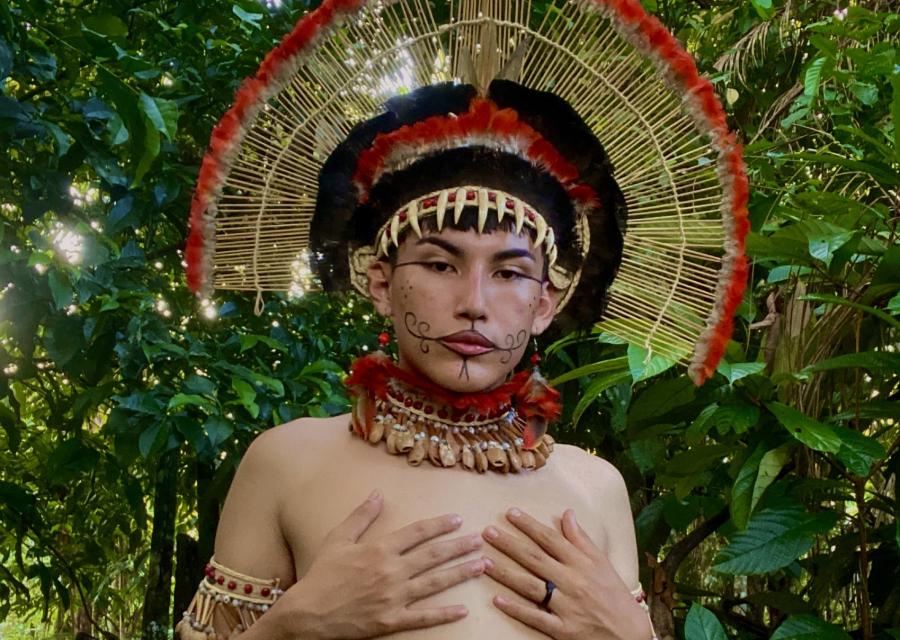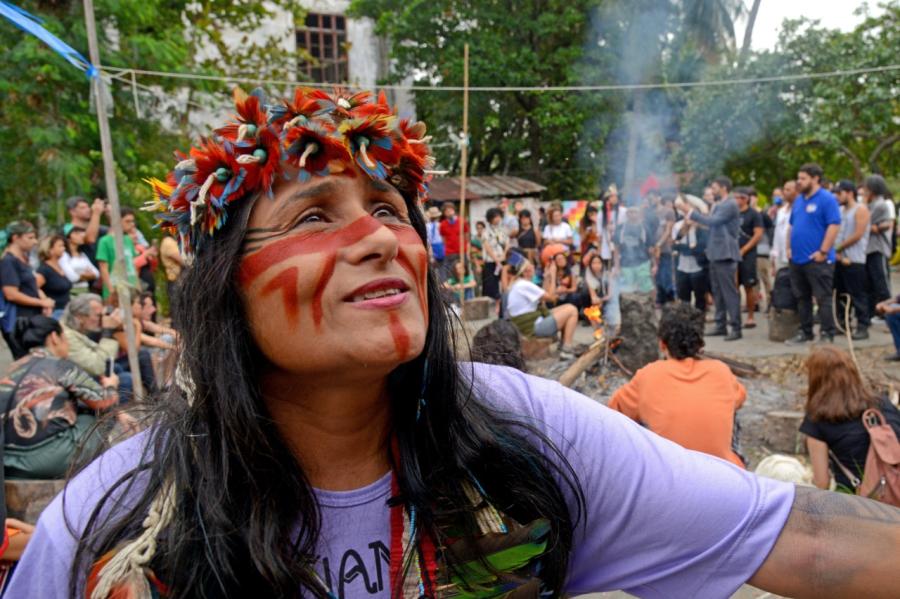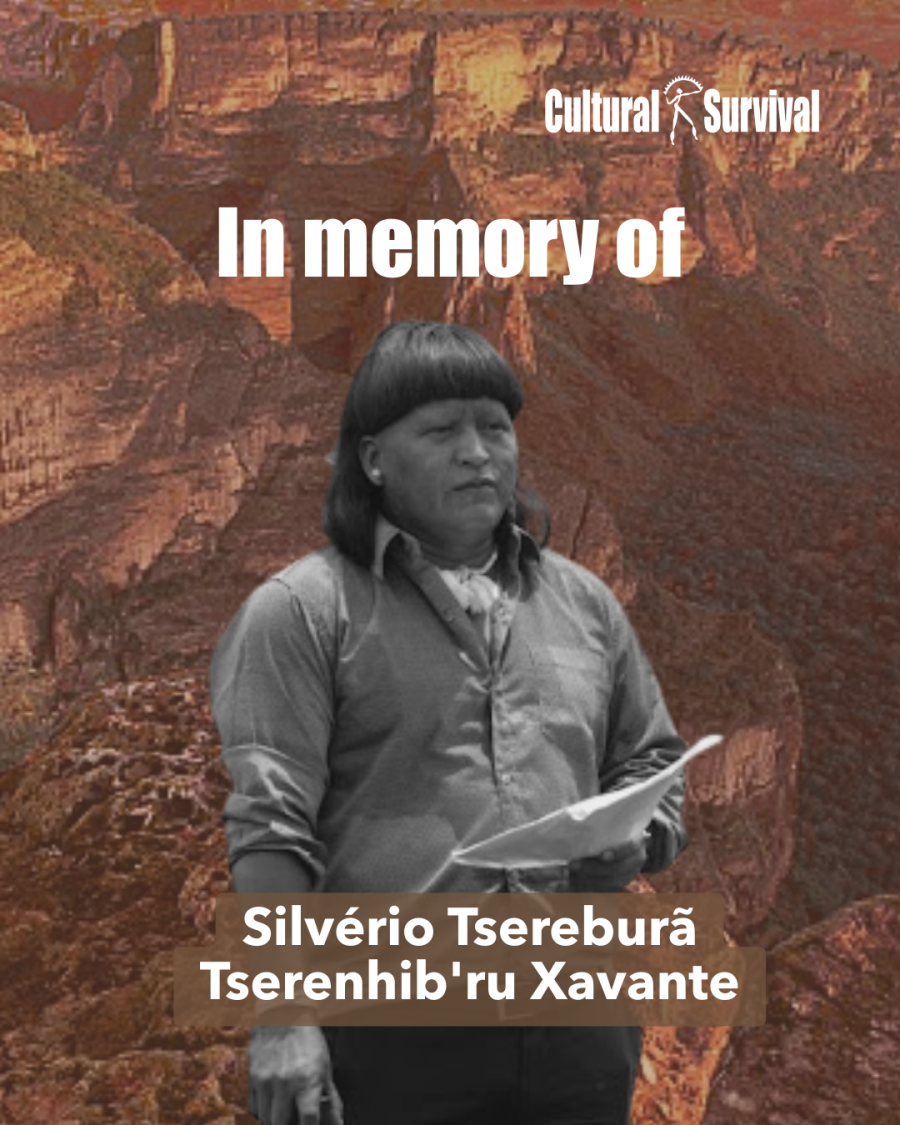Xavante shaman Waparia, the first Brazilian Amazonian Indian to stand before a UN podium, performs a ritual of healing so that Summit participants will comprehend the sacred and global role played by indigenous forest dwellers. As a caretaker of what remains of the Amazon forests, Waparia offers a warning. Respect the shaman. Respect indigenous leadership. Demarcate the lands of the Indians and protect their territories and sacred forests, and they, as keepers of the earth's lungs, will allow the world's population continued breath with which to speak words of wisdom.
Lakota spiritual leader Orvil Looking Horse, 19(th) Generation Keeper of the White Buffalo Calf Pipe, describes the heart-shaped Black Hills of South Dakota. Aerial photos of the hills over the four seasons show the sacred heart pumping -- the ancient health-giving and revitalizing beat of Mother Earth. To hold a purification ceremony (sweat lodge) in the Black Hills, Looking Horse must first obtain a permit, pay insurance money, and be lectured by petty forestry bureaucrats on garbage disposal; yet the logging trucks fly past as he watches, covering him in clouds of dust. It was prophesied that following the birth of the white buffalo in 1994, the deliverer of the sacred pipe would return once more to bring peace and unity. Looking Horse offers his prayers that this time will come soon.
Angaangaq Lyberth, Greenland spiritual leader from the Eskimo Nation, speaks of the desecration of his remote homeland in the Arctic, a result of the activities of unscrupulous and uncaring energy producers and consumers. Unless we act now, and have indigenous peoples, as the original stewards of the environment, take their rightful place alongside the decision-makers of the world, the lands of both Native and non-Native peoples will be deluged with water because of global warming. Lyberth believes that it is harder to melt the ice in the heart of man than it is to melt the mile-deep ice packs of his native land. He prays that we will all learn from the sacred and environmentally respectful practices of indigenous peoples -- and that we secure their territories -- for the benefit of all life: the two legged, the four legged, the winged, and the finned.
For three days in August, at the invitation of Chief Oren Lyons, Faithkeeper in the Onondaga Nation, I had the unique opportunity to attend, as an observer, an unprecedented and extraordinary gathering of religious and spiritual leaders at the UN Millenium World Peace Summit.
This meeting of the heads of all major denominations -- High Priests, Grand Muftis, Archbishops, Supreme Patriarchs, Chief Rabbis, Monks, and Swamis: His Holinesses, His Excellencys, His Eminences -- was designed to inspire the esteemed attendees to be agents for social change and reconciliation in the world beyond their immediate spheres of influence. Those occupying the 1,945 seats of the UN General Assembly represented or held sway over more than 85 percent of the world's population. By contrast, political leaders who normally occupy these same seats claim the hearts and minds of a far smaller constituency. In so many places, violence on a massive scale is perpetrated in the name of religion; the Middle East and the Balkans are just two examples. This conference presented an opportunity, however idealistic, for spiritual leaders to encourage their congregations in a spirit of forgiving -- to grant pardon where pardon was always denied, and to seek absolution from those who have shown no inclination to grant it.
UN Secretary General Kofi Annan's objective was for these leaders to sign a charter committing themselves, as unparalleled spokespeople for the various faiths (Christianity, Islam, Hinduism, Buddhism, Zoroastrianism, Jainism, Shinto, Taoism, Judaism, Indigenous Religions, etc.) to work with the UN for peace, harmony, and the greater common good of the peoples of the earth. The hundred-strong indigenous contingent demonstrated their desire to be a part of a global reconciliatory effort, but many refused to sign the charter without first consulting other community members. They shared a common concern: indigenous peoples are being called upon to work hand in hand with the UN for. peace, and yet they have no representation within the UN system, and even less representation in those countries enveloping their traditional territories. Indigenous leaders urged the UN to show leadership and prepare the way for a fuller participation by indigenous peoples in domestic and international political arenas.
The summit was a missed opportunity for organizers to promote the rights of disenfranchised first peoples by having Native American religious leaders welcome world visitors. Such a gesture would have demonstrated UN concern for the plight of the many marginalized and landless traditional owners of Turtle Island (North America). Instead, the first day passed with only a short indigenous presentation (by Clan Mother of the Onondaga Nation Audrey Shenendoah) late in the day, when many delegates had departed.
Exalted discussion about solving the problems of an errant humanity was dizzying. Talk was of such grandiloquence that it ushered in a welter of remarkable declarations: "to be a Muslim is to be a peacemaker;" "European or Euro-American Swamis [well-represented at the conference] are best suited to the task of mediation;" "to be indigenous is to be a part of nature, outside the influence of governments, and answerable only to nature." And with each passing session, despite good intentions, an awareness of irreconcilable differences grew. Deep soul-searching and the examination of doctrine for avenues of accommodation seemed futile.
It was probably inevitable that the growing unease and confusion spilled out onto the floor of the assembly during, perhaps ironically, a session on forgiveness. In an ugly scene, spokespeople for two of the world's leading religions nearly came to blows when one referred to the gods of others as barbaric, and the followers of those gods as barbarians. We should perhaps be thankful for their altercation, as it paved the way for a real dialogue on forgiveness. Sudanese Shilluk Tribal Elder and Presbyterian Church Minister Reverend Ezekial Kutjok at first emphasized what everyone already knew: that a majority of the world's great religions were created without consideration for other religions. He stood between the combatants -- it was as if they were his children -- and spoke of the need for a new and more inclusive spiritual pathway. Why not begin by examining the time-tested reconciliatory methodologies of first peoples, he asked. Drawing on his own family traditions, Kutjok relayed to his listeners the healing potential of a ritual known as swilo, where, in a ceremonial setting, one gives up something most precious in the name of peace.
His message of sacrifice for the common good was similar to that repeated many times and in varied ways by other indigenous leaders; no peoples have been asked to give up more than have the earth's indigenous inhabitants. With the advent of colonization, their lives, societies, and cultures were obliterated, often at the behest of religious leaders or in the name of a "civilizing" deity. In the Sudan for the past 20 years, for example, more than 2 million people have been massacred and many more taken into slavery in what is portrayed as an Arab/Christian dispute. In reality, the scenario is a familiar one to indigenous peoples: the insatiable appetite of the dominant sector of society for non-renewable resources, in this case in the once remote and inhospitable indigenous Dinka, Nuba, and Nuer homelands, without regard for indigenous rights.
Accommodation of the Other has been a familiar survival strategy for indigenous peoples. And though tribes have been annihilated, villages destroyed, and lands taken, many groups have survived to tell the story of their sacred links to Mother Earth, of their stewardship of the environment, and of an accumulated wisdom that far outdates even that of the Jains. The story of survival against overwhelming odds was emphasized by all indigenous participants. This message will be one of the summit's more valuable legacies.
Article copyright Cultural Survival, Inc.



